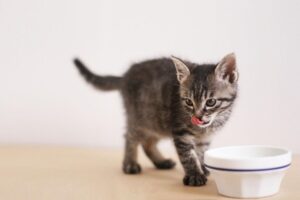What you need to be cautious about when storing cat food is "oxidation." Oxidation begins the moment you open the package.
It is said that oxidized food loses its flavor, leading to decreased palatability. Continuous consumption of oxidized food can also pose risks to the cat's health.
So, this time, we will introduce storage methods to protect your beloved cat's health and ensure they enjoy their meals.
Table of Contents
1. Dry Food Storage Methods
∟ 1-1. Pay attention to storage in direct sunlight and high temperature and humidity
∟ 1-2. After opening, store in a way that minimizes exposure to air
∟ 1-3. If storing for an extended period, seal and freeze
2. Wet Food Storage Methods
3. Avoid these storage methods
∟ 3-1. Storing dry food in the refrigerator
∟ 3-2. Long-term storage in polyethylene bags
∟ 3-3. Storage in a food dispenser
∟ 3-4. Storage in a large-capacity food stocker
1. Dry Food Storage Methods

1-1. Pay attention to storage in direct sunlight and high temperature and humidity
When storing dry food, avoid places with direct sunlight or high temperature and humidity, and store in a cool, dark place.
Especially avoid storage in the following places:
- ・Refrigerator: Prone to condensation due to temperature changes during opening and closing, leading to mold growth
- ・Under the sink: High humidity, possible mold growth
- ・High shelves: Prone to high temperatures, especially during winter with heating in use
- ・Closet: High humidity, concerns about the influence of insect repellents
Recommended places for storing cat food are:
- ・Underfloor storage
- ・Pantry
- ・Cabinet
These places are considered to have no direct sunlight, minimal temperature changes, and low humidity.
1-2. After opening, store in a way that minimizes exposure to air
Cat food oxidizes when exposed to air.
Oxidation of dry food is a phenomenon where fats and amino acids in the food react with oxygen in the air, causing a chemical change.
The most significant factor in the deterioration of cat food is said to be oxidation, leading to a decline in flavor and a gradual reduction in aroma.
Cats judge whether to eat based on aroma rather than taste, so oxidized food may reduce palatability. It can also potentially have adverse effects on health.
Therefore, opened dry food should be stored in a way that minimizes exposure to air.
■ Close the bag opening with a food clip
An easy and inexpensive method is to close the bag opening with a food clip.
Since oxidation occurs when there is a lot of air, close the bag in a state with as little air as possible inside.
Although there are bags with zippers, they are said to have questionable airtightness, so it is recommended to use them in conjunction with a food clip.
However, since it is not completely airtight, there may be some concerns. It is reassuring to put the one closed with a food clip into a sealed container.
■ Put it in a sealed container
Many people store cat food in sealed containers. While transferring and storing is good, it is recommended to put the entire bag into the container.
It is even more secure to put it in a bag with good light and moisture resistance, such as a laminated zip bag.
Although a bit more expensive, vacuum-sealed storage containers are also recommended.
■ Vacuum seal with a vacuum packing machine
The most resistant to oxidation is to vacuum seal using a vacuum packing machine. Minimizing oxidation by storing in small portions is possible.
However, since you need to use disposable bags for the machine, there is a running cost, and the difficulty of bagging is a downside.
If this is not a concern for you, it is recommended.
1-3. If storing for an extended period, seal and freeze
If you have leftovers that you can't finish, consider freezing them.
It is generally recommended to buy in packages that can be consumed within one month.
However, there may be circumstances where only large quantities are available, or small packs are expensive.
When freezing, divide it into small portions immediately after opening the package.
When freezing, put it in a container that can be sealed tightly, and try to keep it in a state where air does not enter as much as possible.
It is recommended to use a vacuum packing machine for this. However, even when frozen, the food deteriorates gradually, so try to consume it within 2-3 months.
Some cats may dislike frozen food, perhaps because the flavor changes slightly. It is recommended to confirm whether your cat will eat a small amount if possible.
Also, if you open it while it is still cold, condensation will occur, so return it to room temperature while still sealed before opening.
2. Wet Food Storage Methods
Opened wet food must be stored in the refrigerator and consumed within 1-2 days.
Also, after opening, transfer it to another container as cans can deteriorate.
Since opened wet food oxidizes like dry food, it is recommended to store it in a sealed container.
Additionally, since bacteria can easily breed in leftover food, discard it.
It is also possible to freeze the portion that cannot be consumed.
Immediately after opening, divide it into daily or meal-sized portions, wrap it in plastic wrap, and put it in a sealed container for freezing.
When freezing, make grooves to break into meal-sized portions later to save effort.
Although it can be stored for up to a month according to some people, it is safe to keep it within 1 week to 10 days for longer periods.
3. Avoid these storage methods
3-1. Storing dry food in the refrigerator
Storing dry food in the refrigerator is actually one of the storage methods to avoid.
The refrigerator is frequently opened and closed, and condensation may occur due to temperature changes, leading to deterioration of flavor and potential mold growth.
Avoid this method.
3-2. Long-term storage in polyethylene bags
Many zipper-type food storage bags are made of polyethylene.
Polyethylene has a slight permeability to air, so it does not prevent oxidation.
This property is also why a blown-up rubber balloon gradually deflates, as it allows air to pass through.
Therefore, while it may be suitable for a few days, it is not suitable for long-term storage.
3-3. Storage in a food dispenser
A food dispenser, which dispenses a predetermined amount of food with knobs or buttons, is convenient and has the advantage of fewer openings and closings of the lid.
However, it does not have high airtightness. As the food decreases, more air enters, and it does not prevent oxidation.
3-4. Storage in a large-capacity food stocker
Storing cat food directly in a large-capacity food stocker requires consideration.
With a large capacity, it may be left inside for a long time. Despite the high airtightness of the container itself, the opportunity for air exposure increases, causing concerns about oxidation.
If using a large-capacity stocker, it is recommended to remove the air from the bag, close it with a food clip, and store the entire bag.



